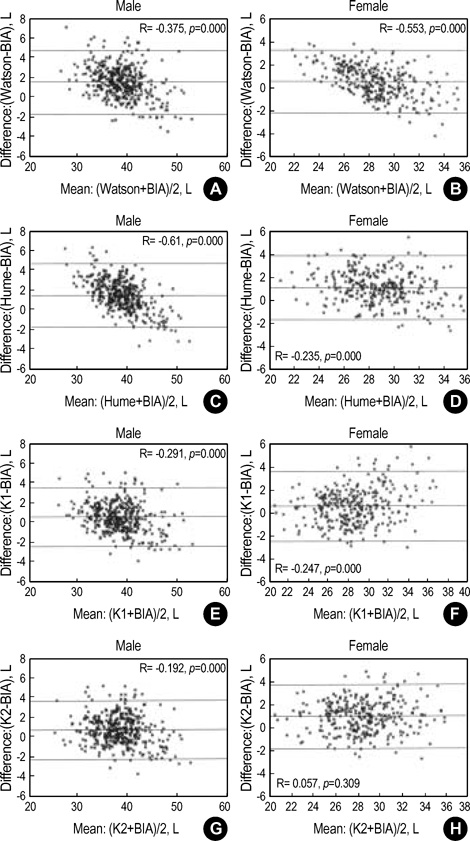J Korean Med Sci.
2005 Jun;20(3):445-449. 10.3346/jkms.2005.20.3.445.
Development of Anthropometry-Based Equations for the Estimation of the Total Body Water in Koreans
- Affiliations
-
- 1Division of Nephrology and Hypertension, Department of Internal Medicine, Kidney Disease Research Group, Inha University College of Medicine, Inchon, Korea. nhkimj@inha.ac.kr
- KMID: 1778504
- DOI: http://doi.org/10.3346/jkms.2005.20.3.445
Abstract
- For developing race-specific anthropometry-based total body water (TBW) equations, we measured TBW using bioelectrical impedance analysis (TBW(BIA)) in 2,943 healthy Korean adults. Among them, 2,223 were used as a reference group. Two equations (TBW(K1) and TBW(K2)) were developed based on age, sex, height, and body weight. The adjusted R2 was 0.908 for TBW(K1) and 0.910 for TBW(K2). The remaining 720 subjects were used for the validation of our results. Watson (TBW(W)) and Hume-Weyers (TBW(H)) formulas were also used. In men, TBW(BIA) showed the highest correlation with TBW(H), followed by TBW(K1), TBW(K2) and TBW(W). TBW(K1) and TBW(K2) showed the lower root mean square errors (RMSE) and mean prediction errors (ME) than TBW(W) and TBW(H). On the Bland-Altman plot, the correlations between the differences and means were smaller for TBW(K2) than for TBW(K1). On the contrary, TBW(BIA) showed the highest correlation with TBW(W), followed by TBW(K2), TBW(K1), and TBW(H) in females. RMSE was smallest in TBW(W), followed by TBW(K2), TBW(K1) and TBW(H). ME was closest to zero for TBW(K2), followed by TBW(K1), TBW(W) and TBW(H). The correlation coefficients between the means and differences were highest in TBW(W), and lowest in TBW(K2). In conclusion, TBW(K2) provides better accuracy with a smaller bias than the TBW(W) or TBW(H) in males. TBW(K2) shows a similar accuracy, but with a smaller bias than TBW(W) in females.
MeSH Terms
Figure
Reference
-
1. Kushner R, Schoeller D. Estimation of total body water by bioelectrical impedance analysis. Am J Clin Nutr. 1986. 44:417–424.
Article2. Bedogni G, Malavolti M, Severi S, Poli M, Mussi C, Fantuzzi AL, Battistini N. Accuracy of an eight-point tactile-electrode impedance method in the assessment of total body water. Eur J Clin Nutr. 2002. 56:1143–1148.
Article3. Watson PE, Watson ID, Batt RD. Total body water volumes for adult males and females estimated from simple anthropometric measurements. Am J Clin Nutr. 1980. 33:27–39.
Article4. Hume R, Weyers E. Relationship between total body water and surface area in normal and obese subjects. J Clin Pathol. 1971. 24:234–238.
Article5. Bland JM, Altman DG. Statistical methods for assessing agreement between two methods of clinical measurement. Lancet. 1986. 1:307–310.
Article6. Moore FD, Olesen KH, McMurrey JD, Parker HV, Ball MC, Boyden CM. The body cell mass and its supporting environment. Body Composition Analysis in Health and Disease. 1963. Philadelphia: W.B. Saunders;1484–1508.7. Gotch FA. Nissenson AR, Fine RN, Gentile DE, editors. Kinetic modeling in hemodialysis. Clinical Dialysis. 1995. ed 3. Englewood Cliffs, NJ: Prentice Hall;156–189.8. Gotch FA, Sargent JA. A mechanistic analysis of the National Cooperative Dialysis Study (NCDS). Kidney Int. 1985. 28:526–534.
Article9. I. NKF-K DOQI clinical practice guidelines for hemodialysis adequacy: update 2000. Am J Kidney Dis. 2001. 37:1 Suppl 1. S7–S64.10. Kim MJ, Lee SW, Song JH. Normal values of total body water in healthy Korean adults: comparison with data from western populations. Yonsei Med J. 2002. 43:363–369.
Article11. Deurenberg P, Wolde-Gebriel Z, Schouten FJ. Validity of predicted total body water and extracellular water using multifrequency bioelectrical impedance in an Ethiopian population. Ann Nutr Metab. 1995. 39:234–241.
Article12. Chumlea WC, Guo SS, Zeller CM, Reo NV, Baumgartner RN, Garry PJ, Wang J, Pierson RN Jr, Heymsfield SB, Siervogel RM. Total body water reference values and prediction equations for adults. Kidney Int. 2001. 59:2250–2258.
Article13. Borgonha S, Petracchi C, Ferro Luzzi A, Shetty PS, Kurpad AV. Prediction of total body water in Indian men from anthropometry and bioelectrical impedance using deuterium dilution as reference. Ann Hum Biol. 1997. 24:355–361.
Article14. Lukaski HC, Johnson PE, Bolonchuk WW, Lykken GI. Assessment of fat-free mass using bioelectrical impedance measurements of the human body. Am J Clin Nutr. 1985. 41:810–817.
Article15. Scheltinga MR, Jacobs DO, Kimbrough TD, Wilmore DW. Identifying body fluid distribution by measuring electrical impedance. J Trauma. 1992. 33:665–670.16. Zhu F, Schneditz D, Levin NW. Sum of segmental bioimpedance analysis during ultrafiltration and hemodialysis reduces sensitivity to changes in body position. Kidney Int. 1999. 56:692–699.
Article
- Full Text Links
- Actions
-
Cited
- CITED
-
- Close
- Share
- Similar articles
-
- A narrative review on the application of doubly labeled water method for estimating energy requirement for Koreans
- Erratum: R-based reproduction of the estimation process hidden behind NONMEM Part 2: First-order conditional estimation
- Establishment and future tasks of estimated energy requirement in 2020 dietary reference intakes for Koreans
- What kind of medical equations and decision trees do physicians want in their daily activities? : Analysis of one-year MedCalc 3000(R) log data
- Development and Cross-Validation of Equation for Estimating Percent Body Fat of Korean Adults According to Body Mass Index


